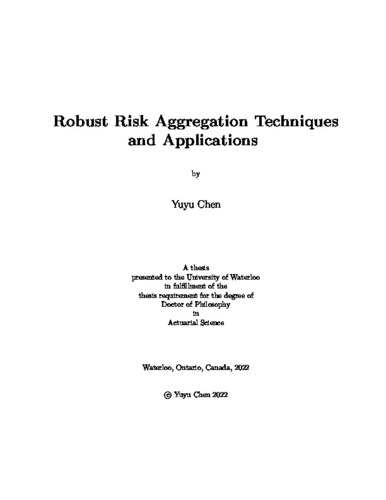| dc.description.abstract | Risk aggregation, which concerns the statistical behaviors of an aggregation position S(X) associated with a random vector X = (X1, . . . , Xn), is an important research topic in risk management, economics, and statistics. The distribution of S(X) is determined by both the marginal behaviors and the joint dependence structure of X. In general, it is challenging to obtain an accurate estimation of the dependence structure of X compared with the estimation of the marginal distributions. Given the marginal distributions of X, this thesis focuses on studying the aggregation position S(X) with different dependence assumptions in different contexts. We will assume that X has a specific dependence structure (e.g., independence), or its dependence structure is (partially) unknown. In particular, for the case that the dependence structure is (partially) unknown, we are interested in the worst-case and the best-case scenarios of S(X).
In Chapter 2, we show the surprising inequality that the weighted average of iid ultra heavy-tailed Pareto losses (with infinite mean) is larger than a standalone loss in the sense of first-order stochastic dominance. This result is further generalized to allow for random total number and weights of Pareto losses and for the losses to be triggered by catastrophic events. We discuss several important implications of these results via an equilibrium analysis of a risk exchange market. First, diversification of ultra heavy-tailed Pareto losses leads to increases in portfolio risk, and thus diversification penalty exists. Second, agents with ultra heavy-tailed Pareto losses will not share risks in a market equilibrium. Third, transferring losses from agents bearing Pareto losses to external parties without any losses may arrive at an equilibrium which benefits every party involved.
In Chapter 3, we focus on aggregation sets, which represent model uncertainty due to unknown dependence structure of random vectors. We investigate ordering relations between two aggregation sets for which the sets of marginals are related by two simple operations: distribution mixtures and quantile mixtures. Intuitively, these operations “ho- homogenize” marginal distributions by making them similar. As a general conclusion from our results, more “homogeneous” marginals lead to a larger aggregation set, and thus more severe model uncertainty, although the situation for quantile mixtures is much more complicated than that for distribution mixtures. We proceed to study inequalities on the worst-case values of risk measures in risk aggregation, which represent the conservative calculation of regulatory capital. Among other results, we obtain an order relation on VaR under quantile mixture for marginal distributions with monotone densities. Numerical results are presented to visualize the theoretical results. Finally, we provide applications on portfolio diversification under dependence uncertainty and merging p-values in multiple hypothesis testing, and discuss the connection of our results to joint mixability.
In Chapter 4, we study the aggregation of two risks when the marginal distributions are known and the dependence structure is unknown, with the additional constraint that one risk is smaller than or equal to the other. Risk aggregation problems with the order constraint are closely related to the recently introduced notion of the directional lower (DL) coupling. The largest aggregate risk in concave order (thus, the smallest aggregate risk in convex order) is attained by the DL coupling. These results are further generalized to calculate the best-case and worst-case values of tail risk measures. In particular, we obtain analytical formulas for bounds on Value-at-Risk. Our numerical results suggest that the new bounds on risk measures with the extra order constraint can greatly improve those with full dependence uncertainty.
In Chapter 5, we study various methods for combining p-values from multiple hypothesis testing into one p-value, under different dependence assumptions of p-values. We say that a combining method is valid for arbitrary dependence if it does not require any assumption on the dependence structure of the p-values, whereas it is valid for some dependence if it requires some specific, perhaps realistic, but unjustifiable, dependence structures. The trade-off between the validity and efficiency of these methods is studied by analyzing the choices of critical values under different dependence assumptions. We introduce the notions of independence-comonotonicity balance (IC-balance) and the price for validity. In particular, IC-balanced methods always produce an identical critical value for independent and perfectly positively dependent p-values, a specific type of insensitivity to a family of dependence assumptions. We show that among two very general classes of merging methods commonly used in practice, the Cauchy combination method and the Simes method are the only IC-balanced ones. Simulation studies and a real-data analysis are conducted to analyze the size and power of various combining methods in the presence of weak and strong dependence. | en |

